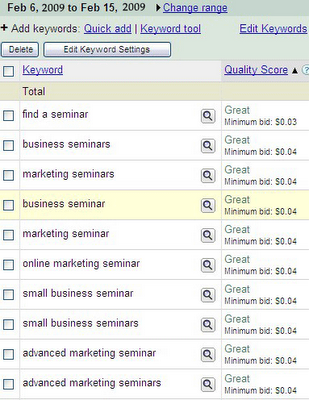Advanced Control Options Now To Target Your Ads
To reach our potential customers in our PPC campaign we used to target our ads in specific geographic locations such as countries, regions, and cities. Now you can prefer to target or exclude your ads based on the user’s physical location or the location of interest.
This new feature can be used when your advertising goals specifically call for more granular controls, because the use of advanced location options will limit your ad exposure.
Targeting method: Target using physical location
If you run a jewelry store in Flora and you want to advertise only to people located near your store. With the existing location targeting in AdWords, you can only specify the location you wish to target, Flora. However, your ad might be shown not only to people in Flora, but also to people elsewhere in the US whose searches include one of your keywords along with the word “Flora”.
If a Flora-based user searching for “Pennsylvania amish jewelry” will not see your ad. This is the case even if your campaign includes that exact keyword.

Exclusion method: Exclude by physical location and search intent
If you want to target sell properties in Chicago and don’t want to advertise to people who are based in Florida or interested in Florida properties, you can go in for restrictive exclusion method by choosing “exclude by physical location and search intent,” as shown below. This makes your ad visible to people based in Florida or to those who include a Florida location in their search queries.

New default working of excluded locations:
If you happen to own a restaurant in Paris, you may want to advertise special deals only to people planning a visit to the city but not to those who live there. Previously, if you excluded Paris from location targeting in AdWords, your ads wouldn’t be shown to people in the city or to those searching for places in Paris. With the new default settings, your ads won’t be shown to people who are in the city, but people outside the city can see these ads if they specify “Paris” in their search queries.

Facebook PPC Verses Google PPC
Facebook is a social network that has had the success of breaking into the social networking sight and surpassing its competitors all the way to its present position at the top of the social media sphere providing its services to over 400 million users.
Facebook provides a PPC (Pay per Click) service that focuses on the various position markets that connect on the social network. The social site allows you to target your ads to only appear on certain profile pages.
Here is a view of the setup and the various demographics on Facebook:
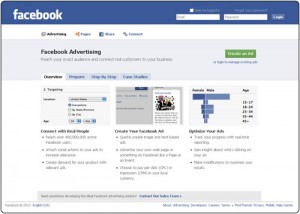
These ads are non-invasive, similar to Google’s PPC, but Facebook allows you to add images and they also provide the user the chance to vote on whether or not they like the advertisement making the ads that much more responsible to their target audience.
Here’s a Facebook’s example of a PPC advertisement:
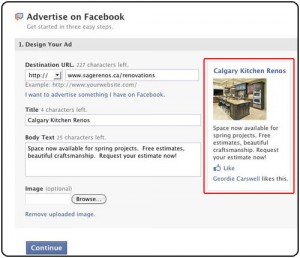
There are issues with Face book’s PPC; for example it is said that Facebook tends to have a very low CTR (Click Through Rate). Also, while Facebook may permit for more targeted niches, it is not a search engine and doesn’t have the volume that Google has. So, although Facebook gives you the capability to enhanced reach those buying your products or services, Google allows for a broader audience and a larger number of prospects.
However, Facebook ads are rapidly gaining in fame, and appear to be a very obliging tool for small to medium businesses attempting to increase traffic with PPC.
If you are trying to choose between the two, the only way to come to the right decision is to try them both and calculate the results over a defined period of time.
Adwords Home Page Now With New Features
Many advertisers want a quick snapshot of account performance and a summary of any important problems to address on their home page of campaign. However, the details vary quite a bit: Some advertisers want to rapidly identify any keywords with bids below their first page bid estimates. Others might want to focus on campaign-level metrics before diving into keyword stats or use a graph to quickly recognize any major fluctuations in performance. In short, customization is key!
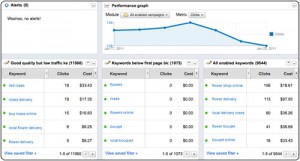
With this in mind, Google has introduced a new version of the AdWords Home tab. Just like before, the page features a summary of account alerts and a graph of account presentation, but it allows for more extensive customization to help you check the parts of your account that matter to you.
The modules on the Home tab are based on saved filters created on your Campaigns tab. This provides you with the flexibility to define accurately which metrics and sections of your account are important to review right when you log in. You can access it now by clicking “New version” on your accessible Account Snapshot page.
You Can Test Your Text And Display Ads With AdWords Campaign Experiments
A few months ago, Google launched AdWords Campaign Experiments (ACE), a free tool that makes it easier to test and accurately measure the impact of changes to your keywords, bids, ad groups, placements – and now ads themselves! ACE permits you to run experimental changes on a percentage of your AdWords traffic. You can compare statistics for experiment versus control traffic and receive statistically important results, which tell you with confidence whether your experimental changes improved your performance.
You can precede ad experiments on both text and display ads. Here are some of the components you can test with each:
Text Ads:
- Ad text
- Headlines
- Display URLs
- Calls to action
Display Ads:
- Images
- Display URLs
- Calls to action
You can test text ads against other text ads and display ads against other display ads, but ACE permits you to do more. If your ads are chosen into the Google Display Network, you can also compare the performance of your text ads to that of your display ads on Display Network sites. If you don’t previously have display ads in your account, they’re easy to create with the display ad builder located within AdWords.
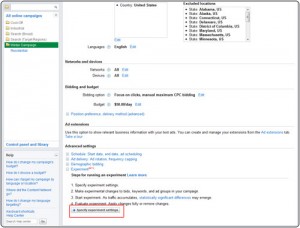
In the earlier times, you may have used ad rotation to test ad variations within an ad group. The main variation between ACE and ad rotation is that ACE allows you to decide the percentage of traffic on which you want your experiment to run – giving you more control over which ads show when. Within each split, ACE will value the “optimize” or “rotate” ad rotation settings you’ve set in your campaign settings tab.
Although this attribute is still in its infancy, for advertisers with an curious mind and a desire to constantly improve their KPI’s, ACE is simply a must have. Ongoing testing should be an important part of campaign management and will result in a much more profitable AdWords account, which of course makes for a profitable campaign soon.
Ultimate Tips For Success In PPC With Google AdWords
Many of us want to find something that will facilitate with the creation and running of ads for our business and we want it to be quick and simple. Google AdWords could be the solution as this is what it is all about. Google AdWords permit us to run our ads on Google as well as on our advertising network despite of our budget and we only pay when our ad is clicked on.
The ads in AdWords are seen to be displayed all along with the search results when “users” search Google using your keywords and this show under “sponsored links” and any other additional positions on top of free search results. This is a good way to guarantee that your ads are being browsed by an audience truly interested in your type of business.
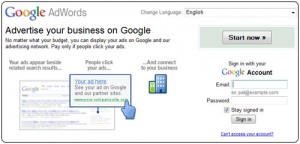
The question that may be left now is how you find success in Google AdWords. There are secrets to the trade and eventually things that could lead you your success – ones that may either be given to you by Google Advertising Professionals or ones that you learn through the course of mastering the trade.
One of the most significant things you want to do is to be “specific” because you truly need to give customers exactly what they want and by being specific. This eventually means that you have to be must be particular with the keywords you choose. Remember that if your campaigns the other way – by getting more common – you will only be spending more money and getting worse results because unless you have the procedure that converts very well for the use of generics you will only be wasting your time and money.
Try to understand the quality score that Google added a couple of years ago to AdWords and although they have been a bit vague about it for a long time, they are now more open in illuminating to you what your quality score is. Remember to be smart in the keywords you add where Google tells you your quality score to help you make sure your score never falls into a poor position. This can happen where you are bidding on a bad collection of keywords.
One more significant thing is “tracking” – where Google AdWords appears to be the best system and most suitable way to set up your keywords and track how well they are really performing. Track whether the clicks are in fact giving you sales or converting into leads because then you are able to see which keywords are actually turning a profit for you or not.
Get High Quality Visitors through Google AdWords
Even if you already have a website that is visually amazing and filled with rich information, it would still be a wasted effort if you do not make sure that people will actually get to visit it. Learning about the many possible methods of driving traffic to your website is surely a must, especially if your website is your main instrument for your business.
Among the many effective means of guaranteeing visitors for your website, pay per click advertising is most likely one of the best. This kind of advertising, however, is done better with the use of Google Adwords, which is why you should first have this.
The very basic step towards this end is to get an account from Google AdWords, a process that is simply and quickly done. There are also other search engines that may offer the same kind of service but Google is the most used among internet users worldwide so it is indeed the best alternative in this regard.
With Google Adwords, you can in fact have ads posted in other sites and blogs associated to yours or in the search engine results page themselves. In this manner, people who are searching for a definite product that you happen to be offering would certainly find your advertisement in the results page after they entered the keywords in the search field.
When people notice your ads and if your ads efficiently raise the level of interest of those who have seen these, then the appeal to click on the ads would be much stronger. The net result would be that more people would find themselves visiting your website and learn more about what you are trying to offer.
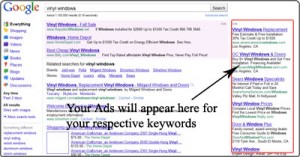
The more traffic that your site gets the better is the chance that your sales would amplify in just a short span of time. Under such circumstances, it is understandable that you should put a limit in the number of ads you post; increase it and have it posted in the most popular sites.
However, it is certainly just the number of ads that matters since these could be many but still ineffective. The ads themselves should create an impact on the internet users, not just by convincing them with the quantity but also by beckoning them by the quality.
If the ads look interesting, the usual tendency of an internet user is to click through it and be led into the website that you maintain. It is, of course, in your website that the visitor is made to understand about your products more.
It is not essential that ads are informative enough since its size is usually too small for that purpose. What is important is that these are effective teasers, ones that would actually entice the user to go to your site.
How to get higher Quality score in Google adwords Pay per click
Before proceeding to know how to get higher Quality Scores, l, we need to understand how a quality score is calculated. Simply stated, a Quality Score is calculated every time your keyword matches a search query – or in other words, every time your keyword has the potential to trigger an ad.
Then, it is necessary to know why Quality Score is important. The Ad Rank or the position an ad shows on a search result or across the content network – is determined by maximum cost per click and quality score. There is a widely accepted formula to arrive at the ad rank and the formula may be stated thus:
| Ad Rank = [(keyword / ad group] quality score) X Max CPC] |
Though somewhat confusing, one needs to understand that for search purposes, the keyword quality score is used and for content the ad group quality score is used. For keywords, every keyword has a quality score fixed to it. So, it is important to keep in mind when talking about ad copy as it will be associated with multiple keywords.
Here’s the step by step instructions on adding your quality score column to your keyword view.
First, navigate to the keywords in your AdGroup. Next, click on the ‘customize columns’ option seen below.

This will let you see the drop down menu:
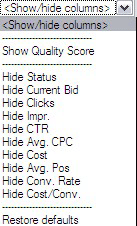
Click on ‘Show Quality Score’. Your AdGroups will now look like this
A keyword’s Quality Score influences its cost-per-click (CPC) that is, how much the advertiser is charged for a click on the ad when it is triggered by a keyword. The higher a keyword’s Quality Score, the lower is its Cost per Click (CPC), and vice versa.
Quality Score also determines, in a way, if a keyword is eligible to enter the ad auction that occurs when a user enters a search query. Usually, the higher the Quality Score, the lower will be the applicable costs and the better your ad position. Every time one of your keywords matches a search query, the combined Quality Score and cost-per-click (CPC) bid is evaluated to see if it’s eligible to enter the ad auction. Keywords with a higher Quality Score will be eligible to enter the auction more easily and at a lower cost.
On the keyword analysis page, there will be a metric called ‘first page bid estimate,’ that means the CPC bid required for your ad to appear on the first page of Google search results assuming the search query exactly matches your keyword. The estimate is obviously based on the Quality Score as well as the advertiser’s competitors for that keyword. However, it is to be noted that succeeding in your first page bid is no guarantee of your ad placement which will depend on Quality Score, your CPC bid, your budget and user and advertiser behavior.
It is to be understood that ads are positioned on search pages and content pages depending on their Ad Rank. The ad with the highest Ad Rank obviously appears in the first position, and the other ads appear in the order of their rankings. For Google, to put it simply, the Ad Rank is determined by your keyword’s Quality Score and (CPC) bid.
Quality score attack by Google
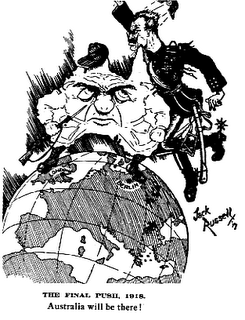
Last week we saw few of our PPC campaigns hit by quality score. It seems the criteria better quality score had been hardened. Now Ad quality is in direct relationship with keywords. It seems we need to use keywords in ads to make it relevant. Also the landing page needs to be well optimized.
Even when the ads are not served often it results in sudden quality score penalty. Google’s quality score penalty is severe and difficult to get rid of. Especially in highly competitive areas quality score plays an important role.
Is word tracker better than Google keyword suggestion tool?
Says so a representative from Word tracker. A word tracker representative was answering a question from a user about the difference with adwords keyword suggestion tool and word tracker keyword tracking tool. He says
“Hi there,
my name’s Mal Darwen, and I work for Wordtracker Customer Services. I hope the following is of some use to you:
Google’s Adwords tool can be a useful addition to the SEO’s toolkit, although it does seem to be more geared towards the PPC market. However, the number of results returned by Google is 200 while with Wordtracker, users get and can download up to 1000 keywords.
We feel that Google is using this new tool to generate new Adwords accounts
from where it makes its money. Word tracker provides an independent keyword
research service on a subscription basis – we do not make money from each
keyword result that people might build on.
While Google reports impressive search volumes, there are a number of
caveats:
- The figures Google provides are not actual searches but approximations. Like WT, Google takes a small sample and extrapolates an estimate from that. From our research that sample appears small but we’re still investigating.
- The default search position is ‘broad match’. This highly inflates the search estimates for a particular keyword.
Broad matches are often less targeted than exact or phrase matches.
- The estimates returned by Google also contain searches from Google’s content network. That’s the wide range of sites that publish Google ads.
- Google are also reporting monthly estimates while Wordtracker provides daily estimates.
This means that on first examination the Google counts will seem much higher than WT.
Wordtracker has always been completely open about where we get our data from. We take our information from two metacrawlers, Dogpile.com and Metacrawler.com. People use such search engines to search Google, MSN and Yahoo at the same time and as such provides very clean bot-free data. We get daily records which represents approximately just under 1% of daily searches across all search engines.
As I say, I hope this makes things a little clearer.”
Adwords success secret from the mouth of a Google employee:
Adwords is a powerful advertising tool it has brought some great success for online Businesses but also there are people who have lost a lot of money in adwords. We have clients spending easily over 30,000$ a month without any proper ROI. They rarely track their ROI I have repeatedly told them that Adwords is not working for them as they expect it to be but still they continue to spend 1000s of dollars in adwords without the campaign working.
Some clients gets an addition towards Adwords they think it like an online gambling tool. The truth it is not only a good strategy and high knowledge will do the work for them. Rather than with limited knowledge they try tactics that never works for them and they fail miserably.
According to adwords advisor:
“* Advertisers who expect to very quickly set up their account and then forget about it – and who do not have either the time or interest to really learn how AdWords works – will almost certainly be disappointed with their success and with the AdWords program itself.
* Advertisers who make only a moderate effort will likely see a moderate success rate at best.
* Advertisers who take advertising with AdWords very seriously, who spend a substantial amount of time learning the nuances of how it works, and who spend a lot of time managing their account, experimenting, learning from the results of those experiments and then updating their account, tracking their Return on Investment (ROI) using the free tools available from AdWords, etc can find AdWords to be a very effective way to affordably send highly qualified potential customers to their site – and make a healthy profit doing it.
Tips for success
1. Identify your advertising goals.
2. Organize your account for maximum effectiveness.
3. Choose relevant keywords and placements.
4. Create straightforward, targeted ads.
5. Optimize your website for conversions.
6. Track your account performance.
7. Test and modify your campaigns to get the results you want.





